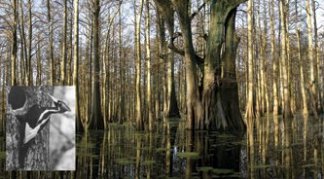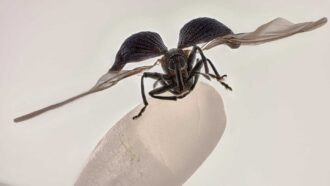Who’s knocking?
Recordings of calls and drumming provide new evidence that the ivory-billed woodpecker survives.
Share this:
- Share via email (Opens in new window) Email
- Click to share on Facebook (Opens in new window) Facebook
- Click to share on X (Opens in new window) X
- Click to share on Pinterest (Opens in new window) Pinterest
- Click to share on Reddit (Opens in new window) Reddit
- Share to Google Classroom (Opens in new window) Google Classroom
- Click to print (Opens in new window) Print
By Emily Sohn
Is it, or isn’t it? That’s been the question on every bird-lover’s lips since April, when scientists announced that the ivory-billed woodpecker is still alive (see “Glimpses of a Legendary Woodpecker“). For the past 60 years, many experts supposed that the bird was extinct. Even after the recent rediscovery, some have refused to believe the reports.
Now, new evidence supports the notion that ivory-billed woodpeckers are indeed living in the Big Woods area of Arkansas.
 |
|
The latest hopes for proving that the ivory-billed woodpecker (inset, from 1930s) hasn’t gone extinct come from sound recordings taken in this area, the Cache River Wildlife Refuge in Arkansas, and neighboring territory.
|
| Cornell Lab of Ornithology |
Researchers from Cornell University in Ithaca, New York, placed digital sound recorders at more than 150 spots in the woodlands of Arkansas and left them there for weeks. In all, they collected about 18,000 hours of sound.
Within the recordings, the Cornell scientists hear what they say could be the ivory-billed woodpecker’s distinctive sharp calls, which sound like “kent.” The recorders also picked up several dozen examples of a double-knocking sound, typical of the way an ivory-billed woodpecker is supposed to drum on a tree.
On the lab’s Web site (www.birds.cornell.edu/ivory/), the scientists have posted the new recordings, along with recordings from the 1930s. Computer analyses show that the recent calls are very similar to the 1930s sounds, which definitely come from ivory-billed woodpeckers. You can listen to the recordings, compare the sounds, and decide for yourself.
Critics who challenged the first claims (which included seven sightings and 4 seconds of blurry video footage) have been more accepting of the new sound recordings. Still, doubts remain. The bird in the original video looks like a pileated, not ivory-billed, woodpecker to some people.
Moreover, the sounds are not complete proof by themselves, the Cornell scientists say. Several people bird-watching in the Arkansas woods have said that blue jays there sometimes make an odd tooting sound. The recorded calls sound a little like them. To check this, the Cornell team plans to record blue jay calls in Arkansas.
So far, there’s no proof that will satisfy everyone. The only clincher, it seems, will be a clear, close-up photograph. Somebody still needs to take that picture.—E. Sohn
Going Deeper:
Milius, Susan. 2005. What’s that knocking? Sound evidence offered for long-lost woodpecker. Science News 168(Aug. 27):134. Available at http://www.sciencenews.org/articles/20050827/fob8.asp .
Sohn, Emily. 2005. Glimpses of a legendary woodpecker. Science News for Kids (May 11). Available at http://www.sciencenewsforkids.org/articles/20050511/Note2.asp .
Additional information about the ivory-billed woodpecker can be found at www.birds.cornell.edu/ivory/ (Cornell University).







